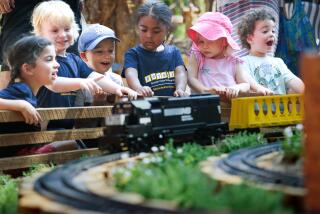A Model Society Built Around the Railroad
- Share via
TROY, N.Y. — Among America’s more than 250,000 model railroaders, John Nehrich is a living legend.
When he graduated from Rensselaer Polytechnic Institute in 1972, he gave up a career as a chemist to devote his life to a model railroad layout in the basement of a college dorm.
He spends at least 60 hours a week working on the massive layout that he and RPI students painstakingly have put together over the last two decades.
Nehrich, 39, is paid $10,000 a year by the RPI student union for his work as director and adviser to the Rensselaer Model Railroad Society.
“I live an austere existence. I don’t have a car. My home is an inexpensive one-room apartment. Sure, I could go out and be a chemist and make a decent living, but I don’t want to leave the layout,” Nehrich explains.
The model railroad in the basement of Davison Hall isn’t your run-of-the-mill collection of trains, tracks, trestles and tunnels.
“It’s one of the largest, finest, most detailed and historically accurate model railroad layouts anywhere in the world,” says Andy Sperandeo.
Sperandeo ought to know. He’s associate editor of the Milwaukee-based bible of the hobby, Model Railroader, a 55-year-old monthly with a circulation of 205,000.
Rensselaer Polytechnic Institute on the shores of the Hudson River in Upstate New York is a 165-year-old school renowned for its engineering program.
It is one of a handful of universities with model railroad clubs. Purdue, Syracuse and MIT also have them.
In 1947, five male students founded the Rensselaer Model Railroad Society. The current club roster lists 98 men and two women.
Nehrich joined in 1968 when he was a freshman. Three years later, the Rensselaer Model Railroad Society moved to its new location, three huge rooms in the dorm basement, and the present layout was launched.
“What we are doing is recreating in miniature a 380-mile railroad route from Grand Central Station in New York City to Windsor Station in Montreal with two dozen cities and towns along the way depicted with precise historic accuracy,” explained Nehrich. “We expect it will take another five years to complete.”
Downtown areas of the cities and towns are reproduced as they existed Sept. 25, 1950, complete with tiny figures of people dressed in clothing typical of the period. Miniature cars have 1950 license plates. Scaled-down 1950 billboards are re-created.
“Railroading was at its peak then. Troy’s huge ornate 1910 railroad station was jammed with passengers awaiting trains. The depot has been gone for years,” said Nehrich, sighing as he stood above the model of the town as it was 40 years ago. “The whole downtown is different today.”
Model railroad hobbyists from all over the country make it a point to visit the Rensselaer layout. It has been featured in Model Railroader and other publications. Among model railroaders it is one of the best-known layouts in the nation.
The layout is open Saturdays to the public. “One Saturday 600 people were jammed in the basement. They could hardly budge,” recalled Nehrich.
Every other Sunday club members meet to spend hours re-enacting true-to-life railroad activities such as “making up” trains, moving cargo, running passenger schedules, and servicing engines in roundhouses.
The club has 50 engines, nearly 500 cars. It takes a half hour for a train to negotiate the entire run. At times as many as 20 trains are operating simultaneously.
Trains pass through walls from room to room, through tunnels, over trestles and causeways, by mountains covered with dense miniature forests in vivid fall colors.
Previous members, some dating back to the club’s beginning 42 years ago, frequently drop by to help work on the layout. Ray Hessinger, 22, who was last year’s club president, graduated in June and took a job as a civil engineer in nearby Albany so he could continue to work with the trains.
“I’m like John Nehrich. I can’t see myself living away from the layout,” said Hessinger, who spends all his free time in the dorm basement.
The RPI students aren’t the only model fanatics. A recent survey by Model Railroader revealed that hobbyists spent more than $200 million last year on the pastime. The survey showed a steadily increasing interest in model railroading, up 20% over five years ago.
For some, like John Nehrich, model railroading is an obsession. “I can’t get enough of it,” he admits. “I never want to do anything else. My ambitions are consumed by this layout.”
More to Read
Sign up for Essential California
The most important California stories and recommendations in your inbox every morning.
You may occasionally receive promotional content from the Los Angeles Times.










